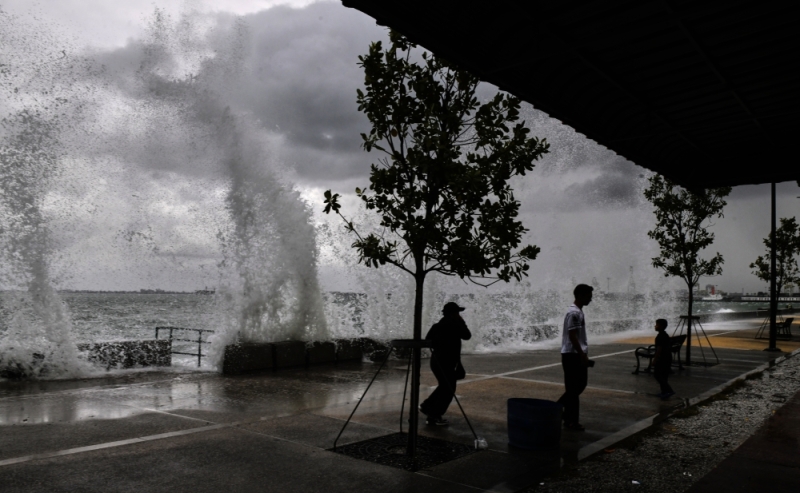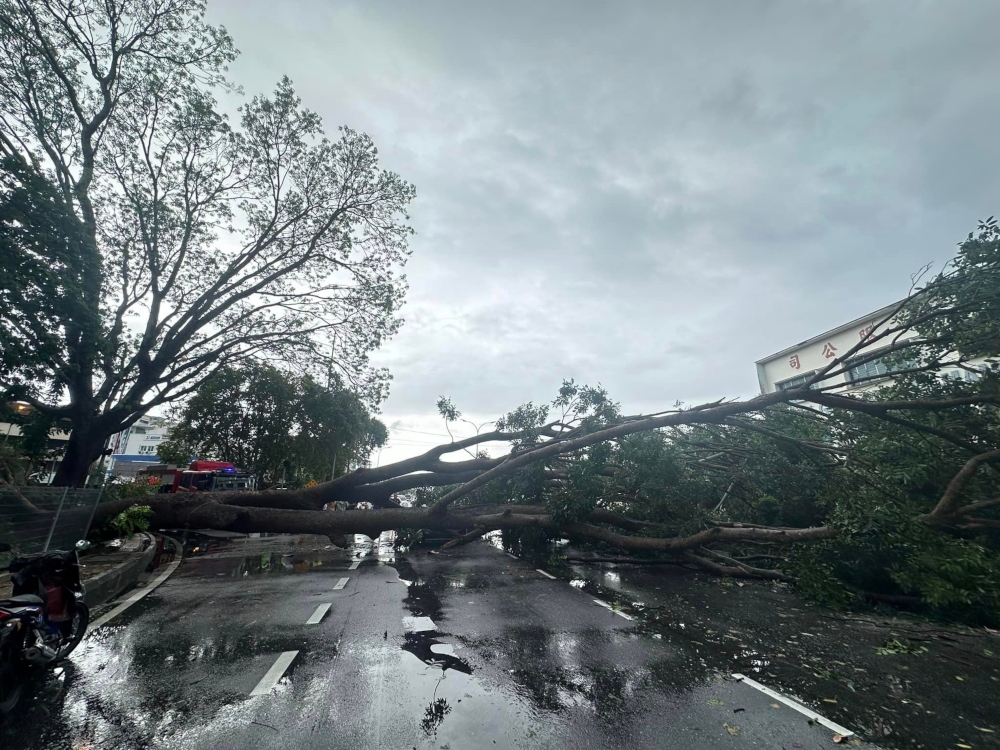
The Sumatra squall: What you didn’t know but should about the severe September storms across Malaysia

Large waves pounded coastal areas in Penang and Pulau Pangkor, Perak from September 17, 2024. — Bernama pic
Friday, 20 Sep 2024 7:00 AM MYT
KUALA LUMPUR, Sept 20 — Penang recently faced severe weather, with heavy rainfall, battering waves, and strong winds uprooting trees in 90 locations, damaging homes and vehicles.
Large waves hit several coastal areas on the mainland, especially around Pantai Bersih in Butterworth.
The traders there and at the Bagan Ajam rest and recreation stop have even posted videos on social media sharing their scary encounters of the waves going right inside their shops and stalls, damaging their equipment, though no lives were lost.
Other locations, such as Padang Kota or Esplanade on Penang Island, were also affected when water overflowed into the Medan Renong food court while it was occupied, forcing the diners to abandon their meals and traders their goods to head to dry land for their own safety.
The state recorded 110 millimetres of rainfall, leading to flash floods in 71 areas, including 43 in Seberang Perai Tengah and 28 in Seberang Perai Selatan.
It’s not climate change this time, or the side effects of the typhoons whirling all over Asia but a phenomenon known as the Sumatran squall.
So what’s the Sumatra squall?
A squall is a sudden, strong burst of wind often accompanied by heavy rain, typically brief but intense.
A Sumatra squall is strong winds formed in the mountainous region on Indonesia’s Sumatra Island and the Straits of Malacca.
It usually manifests as a line of thunderstorms that moves eastward, impacting peninsular Malaysia and neighbouring countries like Singapore.
These storms typically bring intense thundery showers lasting one to two hours, most common from April to November during the southwest monsoon and inter-monsoon periods.
Where else were affected by this squall?
The Sumatra squall was not confined to just Penang. News reports indicate that the stormy weather hit peninsular states like Pahang, Perak, Perlis, and Kelantan, and also Sabah.
In Kuantan, Pahang, an elderly man was killed, and his granddaughter injured when a tree fell on them at a campsite.
On social media, several videos are circulating showing large waves pounding Pulau Pangkor in Perak.
In Sik, Kelantan, 32 trees were uprooted within 10 minutes, damaging several facilities.
In Kuala Perlis, a ferry with 567 passengers ran aground due to strong winds, approximately 0.5 nautical miles from town.
Sabah reported 23 fallen trees as winds reached up to 43 km/h, causing various damages.
Sabah Meteorological Department director Amirzudi Hashim said that the current weather conditions are caused by shifting wind patterns from the south of peninsular Malaysia and the west coast of Sabah.

Friday, 20 Sep 2024 7:00 AM MYT
KUALA LUMPUR, Sept 20 — Penang recently faced severe weather, with heavy rainfall, battering waves, and strong winds uprooting trees in 90 locations, damaging homes and vehicles.
Large waves hit several coastal areas on the mainland, especially around Pantai Bersih in Butterworth.
The traders there and at the Bagan Ajam rest and recreation stop have even posted videos on social media sharing their scary encounters of the waves going right inside their shops and stalls, damaging their equipment, though no lives were lost.
Other locations, such as Padang Kota or Esplanade on Penang Island, were also affected when water overflowed into the Medan Renong food court while it was occupied, forcing the diners to abandon their meals and traders their goods to head to dry land for their own safety.
The state recorded 110 millimetres of rainfall, leading to flash floods in 71 areas, including 43 in Seberang Perai Tengah and 28 in Seberang Perai Selatan.
It’s not climate change this time, or the side effects of the typhoons whirling all over Asia but a phenomenon known as the Sumatran squall.
So what’s the Sumatra squall?
A squall is a sudden, strong burst of wind often accompanied by heavy rain, typically brief but intense.
A Sumatra squall is strong winds formed in the mountainous region on Indonesia’s Sumatra Island and the Straits of Malacca.
It usually manifests as a line of thunderstorms that moves eastward, impacting peninsular Malaysia and neighbouring countries like Singapore.
These storms typically bring intense thundery showers lasting one to two hours, most common from April to November during the southwest monsoon and inter-monsoon periods.
Where else were affected by this squall?
The Sumatra squall was not confined to just Penang. News reports indicate that the stormy weather hit peninsular states like Pahang, Perak, Perlis, and Kelantan, and also Sabah.
In Kuantan, Pahang, an elderly man was killed, and his granddaughter injured when a tree fell on them at a campsite.
On social media, several videos are circulating showing large waves pounding Pulau Pangkor in Perak.
In Sik, Kelantan, 32 trees were uprooted within 10 minutes, damaging several facilities.
In Kuala Perlis, a ferry with 567 passengers ran aground due to strong winds, approximately 0.5 nautical miles from town.
Sabah reported 23 fallen trees as winds reached up to 43 km/h, causing various damages.
Sabah Meteorological Department director Amirzudi Hashim said that the current weather conditions are caused by shifting wind patterns from the south of peninsular Malaysia and the west coast of Sabah.

The Penang Island City Council received reports of uprooted trees at 43 locations, while the Seberang Perai City Council (MBSP) received 30 complaints of fallen trees since September 17, 2024. — Picture from Facebook/Balai Bomba Dan Penyelamat Butterworth
What to expect in the next few days?
The Sabah Meteorological Departments has issued a Category Two warning for strong winds and rough seas along Sabah’s west coast, anticipating winds of 50 to 60 km/h and waves up to 4.5 metres from September 17 to 21.
MetMalaysia has also issued a warning of continuous rain for four states in the northern west coast of the peninsula — Perlis, Kedah, Penang, and Perak.
So, pretty much expect wet, blustery weather for the rest of this week.
What to expect in the next few days?
The Sabah Meteorological Departments has issued a Category Two warning for strong winds and rough seas along Sabah’s west coast, anticipating winds of 50 to 60 km/h and waves up to 4.5 metres from September 17 to 21.
MetMalaysia has also issued a warning of continuous rain for four states in the northern west coast of the peninsula — Perlis, Kedah, Penang, and Perak.
So, pretty much expect wet, blustery weather for the rest of this week.
No comments:
Post a Comment